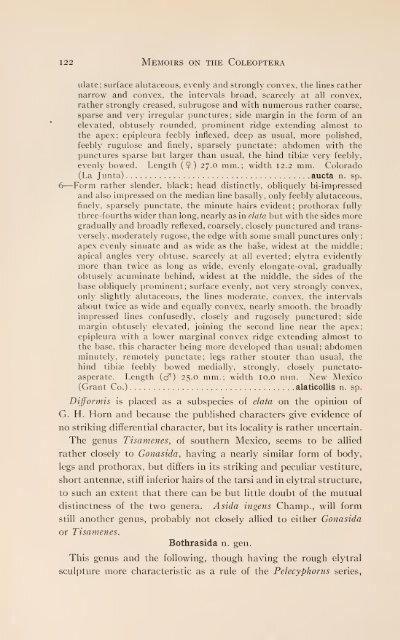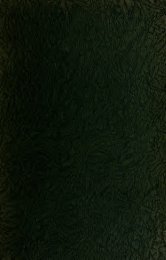Memoirs on the coleoptera
Memoirs on the coleoptera
Memoirs on the coleoptera
You also want an ePaper? Increase the reach of your titles
YUMPU automatically turns print PDFs into web optimized ePapers that Google loves.
122 MEMOIRS ON THE COLEOPTERA<br />
ulate; surface alutaceous, evenly and str<strong>on</strong>gly c<strong>on</strong>vex, <strong>the</strong> lines ra<strong>the</strong>r<br />
narrow and c<strong>on</strong>vex, <strong>the</strong> intervals broad, scarcely at all c<strong>on</strong>vex,<br />
ra<strong>the</strong>r str<strong>on</strong>gly creased, subrugose and with numerous ra<strong>the</strong>r coarse,<br />
sparse and very irregular punctures; side margin in <strong>the</strong> form of an<br />
elevated, obtusely rounded, prominent ridge extending almost to<br />
<strong>the</strong> apex; epipleura feebly inflexed, deep as 6<br />
usual, more polished,<br />
feebly rugulose and finely, sparsely punctate; abdomen with <strong>the</strong><br />
punctures sparse but larger than usual, <strong>the</strong> hind tibiae very feebly,<br />
evenly bowed. Length (9) 27.0 mm.; width 12.2 mm. Colorado<br />
(La Junta) aucta n. sp.<br />
Form ra<strong>the</strong>r slender, black; head distinctly, obliquely bi-impressed<br />
and also impressed <strong>on</strong> <strong>the</strong> median line basally, <strong>on</strong>ly feebly alutaceous,<br />
finely, sparsely punctate, <strong>the</strong> minute hairs evident; prothorax fully<br />
three-fourths wider than l<strong>on</strong>g, nearly as in data but with <strong>the</strong> sides more<br />
gradually and broadly reflexed, coarsely, closely punctured and trans-<br />
versely, moderately rugose, <strong>the</strong> edge with some small punctures <strong>on</strong>ly;<br />
apex evenly sinuate and as wide as <strong>the</strong> base, widest at <strong>the</strong> middle;<br />
apical angles very obtuse, scarcely at all everted; elytra evidently<br />
more than twice as l<strong>on</strong>g as wide, evenly el<strong>on</strong>gate-oval, gradually<br />
obtusely acuminate behind, widest at <strong>the</strong> middle, <strong>the</strong> sides of <strong>the</strong><br />
base obliquely prominent; surface evenly, not very str<strong>on</strong>gly c<strong>on</strong>vex,<br />
<strong>on</strong>ly slightly alutaceous, <strong>the</strong> lines moderate, c<strong>on</strong>vex, <strong>the</strong> intervals<br />
about twice as wide and equally c<strong>on</strong>vex, nearly smooth, <strong>the</strong> broadly<br />
impressed lines c<strong>on</strong>fusedly, closely and rugosely punctured; side<br />
margin obtusely elevated, joining <strong>the</strong> sec<strong>on</strong>d line near <strong>the</strong> apex;<br />
epipleura with a lower marginal c<strong>on</strong>vex ridge extending almost to<br />
<strong>the</strong> base, this character being more developed than usual; abdomen<br />
minutely, remotely punctate; legs ra<strong>the</strong>r stouter than usual, <strong>the</strong><br />
hind tibiae feebly bowed medially, str<strong>on</strong>gly, closely punctatoasperate.<br />
Length (cf) 25.0 mm.; width 10.0 mm. New Mexico<br />
(Grant Co.) alaticollis n. sp.<br />
Difformis is placed as a subspecies of data <strong>on</strong> <strong>the</strong> opini<strong>on</strong> of<br />
G. H. Horn and because <strong>the</strong> published characters give evidence of<br />
no striking differential character, but its locality is ra<strong>the</strong>r uncertain.<br />
The genus Tisamenes, of sou<strong>the</strong>rn Mexico, seems to be allied<br />
ra<strong>the</strong>r closely to G<strong>on</strong>asida, having a nearly similar form of body,<br />
legs and prothorax, but differs in its striking and peculiar vestiture,<br />
short antennae, stiff inferior hairs of <strong>the</strong> tarsi and in elytral structure,<br />
to such an extent that <strong>the</strong>re can be but little doubt of <strong>the</strong> mutual<br />
distinctness of <strong>the</strong> two genera. Asida ingens Champ., will form<br />
still ano<strong>the</strong>r genus, probably not closely allied to ei<strong>the</strong>r G<strong>on</strong>asida<br />
or Tisamenes.<br />
Bothrasida n. gen.<br />
This genus and <strong>the</strong> following, though having <strong>the</strong> rough elytral<br />
sculpture more characteristic as a rule of <strong>the</strong> Pelecyphorus series,



